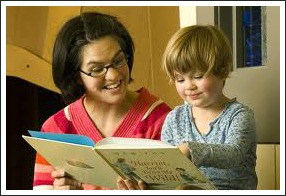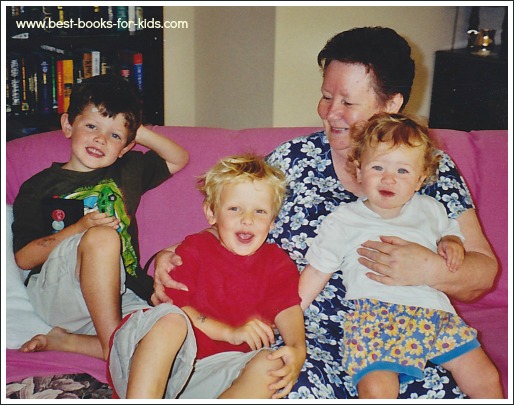Teaching Preschoolers About Feelings
Teaching preschoolers about feelings is an important part of their emotional development.
In the last ten years there has been a great deal of research into emotional development and we now know that it's very important for children's social functioning throughout their lives that we help them to develop skills around emotional competence.
Parents teach emotional competence skills by modelling and by talking about them but reading books together can be a great help.

Books are not the only tools you can use to teach your children about feelings but they are a fun way to get the message across and you can use almost any good picture book.
On this page I give a few examples and explain how you can use the books to get your child thinking, firstly about their own feelings and then also about other people's feelings.
Why Teaching Preschoolers About Feelings Matters
Children don't naturally or automatically understand feelings.
From the time they're babies, they feel fear, happiness, sadness and many of the emotions adults feel but they don't understand what they're feeling.
They also don't understand why they're feeling that way and they can't name their feelings.
They need us to help them understand how they're feeling and why.
Helping your children to name their feelings and to understand why they feel a certain way is an important step in their emotional development.
As they mature and learn to understand their own emotions, we can gently help them to understand that other people have feelings too and to recognise the signs that show how another person is feeling.
A word of caution though: it's important not to rush this process of teaching preschoolers about feelings. Before the age of two, children simply aren't developmentally able to understand that other people have feelings that may be different from their own.
Babies as young as one year have some rudiments of empathy but psychologists say that it's not until they're about four that children understand that other people may have beliefs that are different from their own.

Emotional Competence Skills
Researchers have described seven skills of emotional competence:
- Awareness of our own emotions;
- Ability to discern the emotions of others;
- Ability to talk about emotions, using appropriate vocabulary;
- Capacity for empathy and sympathy;
- Ability to cope with unpleasant emotions;
- Awareness that relationships are partly defined by emotional expressions;
- Emotional self-efficacy;
The idea is that children need to learn the first skill before they can learn the second and so on. However, looking at this list, I guess we can all see that some adults never reach the higher levels of emotional competence at all and some of us don't get there until we're well into adulthood.
Given how important these skills are for children if they're to function well in society, it makes sense to do everything you can to help them along and conversations around books are a great way to do this.
Using Books to Teach Preschoolers about Feelings
Using books to teach preschoolers about feelings essentially involves asking questions which prompt your child to think - in an age-appropriate way - about feelings.
For example, if you're reading The Tale of Peter Rabbit, you might stop after reading page 6 where Mr McGregor begins to chase Peter and say something like "oh dear, poor Peter! How do you think Peter feels?" If your child is very young, you could then say "do you think he feels frightened?"
If your child is older, he or she will probably tell you straight out that Peter feels frightened. You can then have a chat about why Peter might feel that way and share how you feel when you are frightened.
You could say something like "do you remember a time when you felt frightened? When was that? Sometimes when we're frightened, we breathe very quickly, like this" (and then you demonstrate).
Conversations like this are the beginning of thinking and talking about feelings.
Books and stories with human characters are a really good starting point for talking about facial expressions, which is a great way to help your child develop empathy.
Here are some books for specific situations:
For a child who is feeling left out and confused after the arrival of a new baby in the family ...
Koala Lou by Mem Fox
For a child who is experiencing problems with a sibling ...
The Pain and the Great One by Judy Blume
What's Empathy And Why Is It Important?
Empathy is the ability to recognize and to share, at least to some extent, feelings such as sadness or happiness that another person or animal is feeling.
Until I had my own children, I never thought much about the importance of empathy or how we develop the ability to empathize with other people.
But then my kids came along and I realised that one of the things I wanted most was for them to enjoy happy, positive relationships with the people in their lives.
This led me to think about why some people seem to have that knack of getting on well with everyone they meet and to read about things like emotional intelligence and development. I thought about the people I know who have great social skills and I realised that the ability to truly understand and feel other people's feelings is an important part of it.
As my oldest two children began to grow, I started to understand that this was one of the things parents have to consciously teach children and I began to think about how to do this.
The books on the right were firm favourites in our house and are particularly good for using to talk about feelings.
This isn't all that complicated. As you read, simply stop every now and again and ask questions like:
"How do you think Susie feels? I think you're right. I think she feels sad too. How do you know she feels sad?"
Or, if your child is very young, you can simply say: "Susie is sad because she lost her teddy."
This kind of talking does three main things:
- it gives your child a vocabulary for understanding and talking about emotions;
- it emphasizes the importance of emotions;
- it helps them recognise the ways in which people express emotions;
These skills are so very important and reading together is a great way to teach them.
References:
Hirsh-Pasek, K; Golinkoff, R; & Eyer, D. (2003). Einstein Never Used Flash Cards. USA: Rodale Inc.
Siegel, D.J; & Hartzell, M. (2005).
Parenting from the Inside Out. Los Angeles : Penguin.
home >>> books for young children >>> teaching preschoolers about feelings